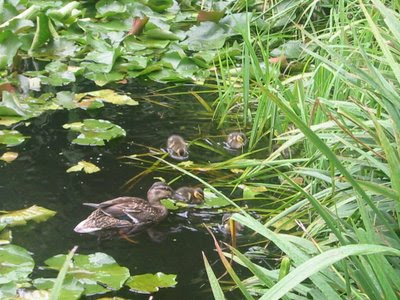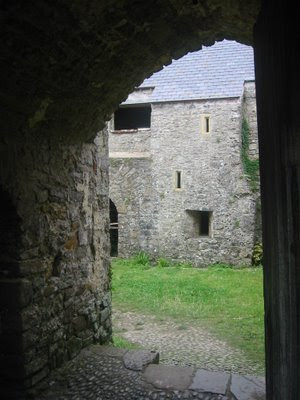The village is the real thing, and for hundreds of years, lay people have lived on the island to aid the monks in their work cultivating the land for a bit of income. There is a medieval fish pond, now somewhat reduced in size and containing mostly water lillies,

ducks and moor hens. (BTW: click on the pics to make them big).

The post office contains the small but very interesting museum that has artifacts of the island's human inhabitants going back to the neolithic. There are a couple of skulls in cases where the note says they were found in a cave on one side of the island where human beings lived or camped 40,000 years ago. Quite a good collection of flint tools and some bronze age things. As well as photos of the island's Victorian and early 20th century inhabitants.

The post office on Caldey Island is possibly the only one in the Kingdom with a crucifix on the back wall.

The islanders live now mostly in a set of cottages in the village, shaded by the woods (planted recently, in the old days, the island was pretty much treeless) and the monastery, up on its hill.

One of the ancient stone cottages, dating probably to Norman times.

Modern cottages and the village green.

Some of the cottages are the traditional Welsh stone kind, but some of them closely resembled the sort of thing that is common on the Gulf Islands of British Columbia.
One of the ladies who worked in the monks' perfume shop said she had lived on the island for 37 years, having been born and raised in Tenby. She said that on a clear day with a good set of binoculars, she could see if her mother was at home watching telly.

There are three churches, all of which are still in use, on the island. St. David's parish church, a Norman chapel built to serve the spiritual needs of the lay islanders.

This is also where the small cemetery is. I noted that the grave markers were of both monks and laymen. The last one said below its cross "Stone ossuary containing ancient human remains".
Swallows were nesting, and swooping madly in and out, in the rafters of St. David's. Due to bad timing and lack of planning, we managed to miss every one of the religious services on the island, but Mass is offered here every day. There was a sign on the door asking visitors not to close the door to allow the swallows in and out.
Just outside the gate of the churchyard of St. David's there is a garden with a sign saying that in the very early days of the Celtic monks, (4th century), this area was the monks' herb and vegetable garden.

The sign said that in those days the ocean came right up to the base of the hill, which would have left the island much smaller then. (Those monks must have been doing some kind of heavy industry back then to have created all those greenhouse gases and causing global warming. Who knew?)
The real treat was the short climb up the hill to the Old Priory, formerly a fortified Norman mansion, where the monks lived until the Dissolution.

Here, St Illtyd's Church is still in use, built on the site of the ancient Celtic monastic chapel. To the left you can see the Norman arch that leads into the courtyard of the house that was the Benedictines' monastic enclosure. The short spire to the left is actually a medieval chimney for the large fireplace inside, which means that the house was very modern and well-built indeed.

and the medieval monks' choir stalls are still there.
There is a sign on the door that says that a novena of Masses is offered for the intentions of everyone who prays in this chapel. The sanctuary, which is a single stone vault probably dating to the 7th century, contained a victorian organ,

several small kneelers

and an altar.

The walls and furnishings are festooned with little slips of paper upon which people had asked for the monks' prayers. This is the ancient stone piscina.

The small nave of St Illtyd's was built later, at the same time as the house,

and contains one stained glass window (modern)

and an ancient megalithic stone, the Caldey Stone. Inscribed upon this is an inscription in a Celtic language, but, most fascinating of all, it also has

Oghams on the side.
The stone was dug up in an adjacent field, thought to have been a Celtic burial ground. For many years its historical importance was not recognized and it was used as a windowsill, later becoming a garden seat.
I'd read about Oghams as a child and was fascinated by what I thought was probably the most obscure (and impractical)form of writing ever created by man. I never thought I'd get to see any close up; still less to touch them.

A closer view of the entry arch next the church. To the left you can see the doorway that leads into what seems to have been the monks' warming room, with a large stone hearth and the chimney. Above this is a loft accessible by a set of stone steps on the outside.

Going inside, the arch leads to the inner courtyard, one side of which is formed by the nave of the church. Note the beach pebble pathways and flooring. Must have been more than a little penitential to kneel on.

Standing in the small courtyard, looking back at the warming room house.

Looking towards the church from inside the courtyard. The buildings to the left were clearly dormitories, refectory and possibly chapter house.

The front of the house, as you come up the hill. The front garden is walled around and is now no more than weeds, but the arches are there.

Those who are fond of Norman architecture will love the Old Priory buildings. Lots of lovely stone Norman and pointed gothic arches.

Apart from the ancient vaulted sanctuary (formerly the entire church) of St. Illtyd's, this is the oldest part of the Old Priory buildings, the Prior's Tower, thought to have been built as a fortified house by Robert Fitzmartin, to whom Caldey was given by Henry I.


The spire of St. Illtyd's was a later addition, only 14th century.

The front of the house from the other side of the mill pond with St. Illtyd's spire.
I loved this tour of ancient and still current good things. Uplifting, truly. Thanks,
ReplyDeleteAJM
Lovely pics. Thanks. FrTT
ReplyDeleteBreathtakingly gorgeous. You've just given me another destination. Thank you!
ReplyDeleteWow, that's just beautiful! Thanks for putting up the pics!
ReplyDelete